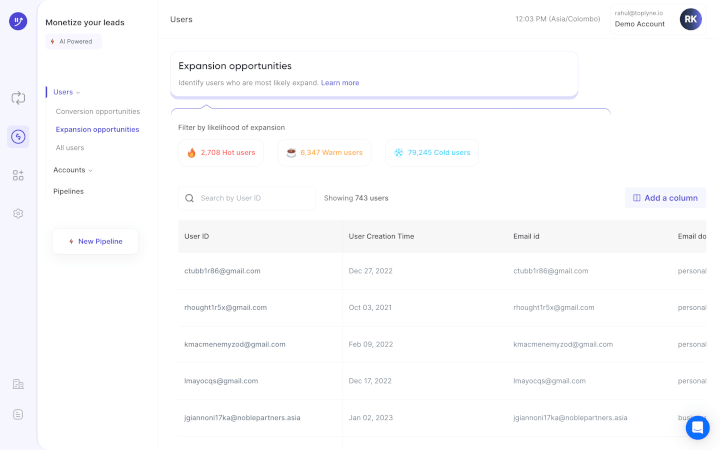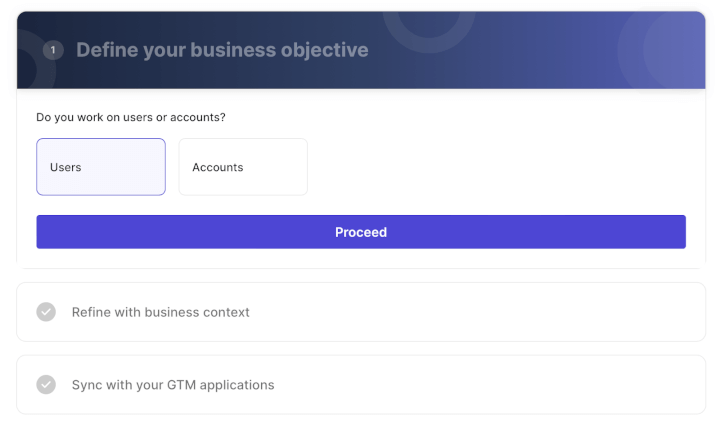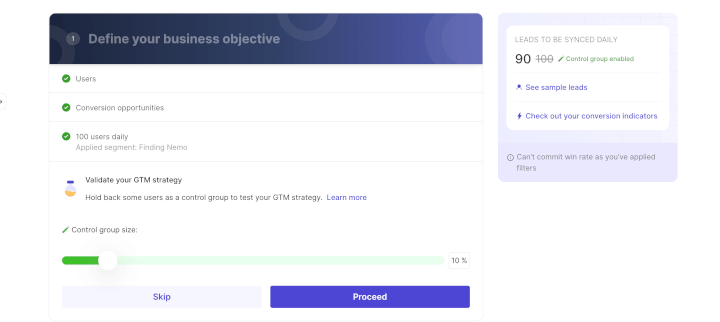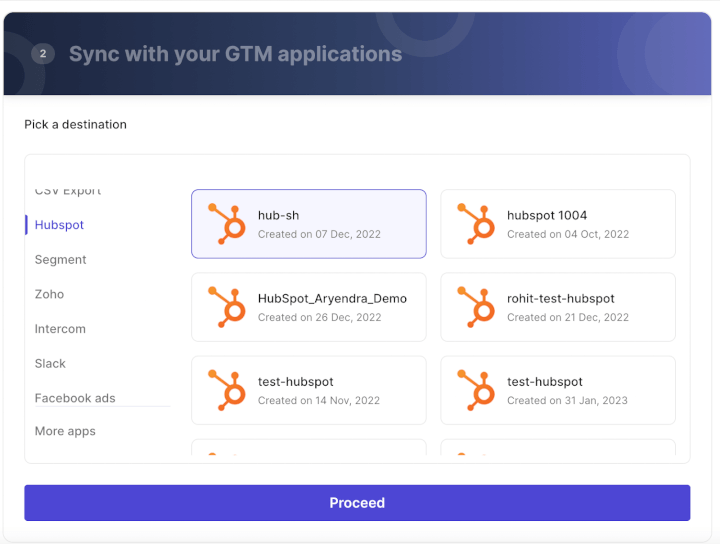Eloqua Lead Scoring 101 (Steps, Best Practices & More!)

Got tons of leads? Well done!
But your work doesn’t end here.
You need to find out which leads are really interested in your product and can be passed on to your sales team.
That's where Eloqua lead scoring comes in.
It takes the guesswork out of the game by determining the sales-readiness of any lead so your team reaches out at the right time and successfully closes the deal.

Wondering how to use the Eloqua lead scoring model?
In this article, we’ll explore the four fundamental steps and best practices involved in the Eloqua lead scoring system. Additionally, we’ll highlight three limitations to be wary of.
Finally, we’ll introduce you to a powerful tool that can help you go beyond ranking leads and ramp up your revenue.
Let’s go!
What is Lead Scoring?
Lead scoring is the process of assigning numerical values to each lead, indicating their interest level in your product.
The score indicates when a lead needs further nurturing by the marketer and when your sales reps should make the call.
You know how it feels when people want you to pick an ice cream flavor, but all you want is to take your time with the testers? 🍨🍦🍨
Similarly, sometimes your lead just needs more information or time before buying your product.
So what can you do while your lead makes up their mind?
First, try new ice cream flavors 😋
Then —
Score. Those. Leads.
The sales and marketing team can assign a lead score based on user actions like:
- Feature adoption rate
- Browsing the product pricing pages, etc.
Lead scoring also lays the foundation for account based marketing, where your team can prioritize the highest-value prospects.
Wondering how the lead scoring system works in Eloqua?
Oracle’s Eloqua is a marketing automation tool that uses predictive lead scoring based machine learning to discover the sure-to-convert leads. It uses the past buying behavior data of your high-potential users to create an ideal customer profile.
Based on this information, Eloqua helps you identify which current prospects best fit that profile and optimize your lead scoring efforts.
Let’s see how you can use the Oracle Eloqua marketing automation tool to implement a powerful lead scoring model.
Four Key Steps Involved In Eloqua Lead Scoring
Here’s the step-by-step process for predictive lead scoring in Oracle Eloqua:
Step #1: Define Lead Qualification Criteria
It all starts with a huddle!
Your marketing and sales teams work side-by-side to define the ideal customer profile.
How?
By considering your target audience – those who are most likely to purchase your product.
After several rounds of espresso-fueled ☕ debate and thorough research (analyzing demographic data and past users’ behavior), your team comes up with the lead qualification criteria.
The criteria outline the qualities of a good lead and become the benchmark against which you score your leads from here onwards.
Step #2: Set Up Scoring Criteria and Assign Lead Scores
Oracle Eloqua uses two sets of scoring criteria to evaluate a B2B lead:
- Profile criteria: It includes explicit data about the lead (job title, industry, or company revenues) to populate the contact field. This data helps identify if the prospect is an ideal decision-maker.
Based on the profile criteria you enter, the lead is given a profile score of A, B, C, or D.

- Engagement criteria: It includes implicit data about the lead, such as their response to marketing campaigns and product trials.
In fact, the Eloqua Profiler (a sales tool from the Oracle CX Marketing suite, (formerly Oracle Marketing Cloud) gives you rich insights into the lead’s online activities.
The data reveals the lead's interest in your product and marketing activity, so you can shortlist only the best marketing qualified lead for your sales team.
A bonus?
Your sales reps don’t waste time contacting pointless leads and may even enjoy an extended lunch break!

Based on the engagement criteria, the lead is given an engagement score of 1, 2, 3, or 4.

Once Oracle Eloqua evaluates a lead against the profile and engagement criteria, it combines the scores and assigns each lead a lead score.
In this lead scoring model, A1 is the most qualified lead and D4 is the least qualified lead.
Step #3: Combine the Profile Fit and Engagement Level
After all those hours of brain-racking, you finally have a lead scoring model in place! 🥳
The lead scores help you better visualize the stage at which every lead is in the sales funnel and where you should be directing your marketing efforts.
Here are a few examples of what different lead scores tell you about the lead:

Step #4: Develop a Plan of Action
So, you’ve scored every lead and found their potential to bring you lots of revenue — or the opposite!
Next steps?
Devising the right follow-up action to either close the sale or help leads advance in their buyer’s journey.

Here are a few examples of the follow-up steps for leads based on their scores:

Now that we’re familiar with the lead scoring model of Eloqua, let’s check out the best practices to consider while using this marketing automation software.
Four Best Practices To Maximize the Success of Eloqua Lead Scoring
Here are some tips and tricks to optimize your lead scoring process in Eloqua:
1. Know the Ins and Outs Of The Lead Scoring Tool
Check out these other cool features of Eloqua that your sales and marketing team can benefit from for lead scoring:
- Oracle Eloqua Profiler integrates with the Microsoft Dynamics CRM. This lets you view users’ real-time activity like product trial signups, email click-throughs, website visits, and more.
What’s in it for you?
It helps you score and prioritize leads based on their engagement level. You can even implement a lead routing system where highly valuable leads from the Microsoft Dynamics CRM are allotted to the best agents.
- Program Builder is an automated workflow feature in Eloqua where you can input rules and conditions to optimize your lead scoring efforts.
Based on these rules in the Program Builder, a specific lead gets a particular score. For example, 6 points for using beta features or 3 points for viewing the pricing page.
- Program Canvas is an easy-to-use, drag-and-drop whiteboard that triggers program actions in real-time based on lead score changes.
For example, a lead with a low score is sent to the initial phase of the lead generation campaign for nurturing. A cold contact with growing interest is targeted with relevant marketing activity (in-app notifications, email campaigns, etc.) to encourage conversion.
2. Closely Assess Customer Behavior
Channel your inner Sherlock Holmes 🔎 to understand the leads’ interests based on their interaction with your product and marketing operations.
Nope, we don’t recommend following them around!
But do pay attention to user behaviors such as:
- Subscribing to product newsletters
- Sharing social media posts
- Requesting product demos
- Spending time on specific product features, and more.
You should use product analytics tools to analyze your customers’ interactions with the product.
The downside is that Eloqua doesn’t offer native integrations with product analytics tools.
But wanna hear something cool?
Toplyne does help you connect product analytics tools like Amplitude and Mixpanel to CRM tools like Hubspot. It’s how you’ll convert data into action. 😎
If someone abandons a product trial midway, their lead score will automatically be low.
And when someone requests custom quote for the enterprise plan, you know they’re meant to be:

3. Establish Rules For Negative Scoring
If you thought someone gave you a cold shoulder, you’d think twice before approaching them again, right?
Same goes for your leads.
Set up rules for negative scoring, so you don’t run after pointless leads at the cost of your time and the company’s dime.
Disqualify dead-end leads based on their negative actions like quitting product trials, entering incorrect numbers in contact field, etc.
You don’t want to target your expensive marketing campaigns to poor leads with zero interest in your product.
Imagine: A lead frequently visits your website (career page in particular) and unsubscribes from the mailing list after a few days.

Exactly!
It’s because they may just be looking for a job!
4. Encourage Sales Teams To Be Proactive
Many sales reps make the mistake of drafting a perfect sales email, conducting a great meeting, giving a fantastic product demo, and then…

Big mistake. Time to act NOW!
Ensure that your sales team skips to the good part by proactively following up with any good lead.
For example, any marketing qualified lead with engagement scores of A1 and B1 should be contacted within 24 hours.
Psst…Toplyne can help your sales team identify which users they should reach out to stat!
Lead scoring with Eloqua can be a cakewalk if you follow these best practices.
Or will it…?
Three Critical Challenges of Using Eloqua for Lead Scoring
Here are three challenges of using this marketing automation software for lead scoring:
- The lead scoring tool has a steep learning curve and may not be suitable for someone who isn’t an IT expert.

- Some users feel that the UI of this marketing automation tool is slightly dated and lacks advanced reporting features.
- Oracle Eloqua is quite expensive (as compared to its competitor Salesforce Marketing Cloud) and may not be a viable choice for mid-sized companies.
Now, you may ask:
Is Eloqua enough to boost your lead generation strategy?
Yes, you can score leads with Eloqua.
But you’ll still need a platform that can help you build a high-functioning pipeline of product qualified leads to increase your sales win rate.
Sadly Eloqua cannot help you with this.
But guess who can!
Go Beyond Lead Scoring and Boost Lead Conversion With Toplyne
Toplyne is a one-of-a-kind tool that specializes in recognizing behavioral patterns of your potential leads via in-app behavior.
Why just rank leads when you can close deals in style?
Identify leads meeting active user conditions (using specific product features consistently, reaching maximum usage limit, etc.) and hit the bull’s eye. 🎯
Create a pipeline of the best product-qualified leads that (automatically) gives you more paying customers and helps you unlock more upselling opportunities.
Here’s how companies like Canva and Vercel generate sales pipeline from their self-serve funnel using Toplyne:
- Step 1/7: Create monetization playbooks to surface conversion and expansion opportunities (leads most likely to convert to paying customers, and teams most likely to grow into larger teams)

- Step 2/7: Choose the right leads to target – users (individual users) or accounts (a group of users with an organization).

- Step 3/7: Select the frequency at which you would want leads synced in your GTM apps.

- Step 4/7: Define how many leads you want by either the number of leads or your expected win rate, depending on your sales capacity and GTM strategy.

- Step 5/7: Build custom segments - Build custom segments based on And/Or logic at the deepest level of sub-properties within your product analytics.

- Step 6/7: Validate your GTM strategy - Hold back some users as a control group to test your GTM strategy.

- Step 7/7: Sync your product qualified pipeline into your GTM destinations - CRMs, sales & marketing execution tools, and customer engagement platforms.

Sounds too good to be true?
Toplyne is a behavioral lead scoring tool that can feed into a range of marketing and sales assist tools. Your sales team need not undergo the complex procedure of rejigging their entire tech stack to accommodate Toplyne.
It fits in seamlessly and saves you hours of busywork. (win-win!)
Lead the Way With Profitable Leads
Eloqua lead scoring allows your sales team to spend their time where it counts – with the most qualified leads.
But how do you ensure these leads become paying, repeat customers?
With Toplyne!
Besides spotting high-intent leads, Toplyne will give you ideas on how to boost engagement and conversion.
For instance, enhance customer experience by sending in-app nudges that highlight your product’s exciting new features!
Ready to draw in those all-important leads?
Sign up for Toplyne for free today to engage with the best leads that give you the perfect score every business dreams of!



.svg)









.png)